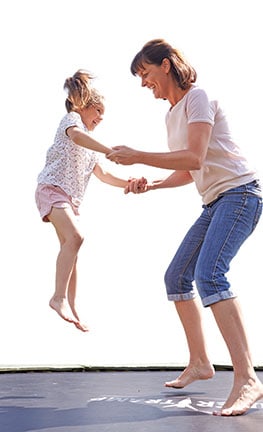DON’T GO THERE
By Martha Thomas
MARCH/APRIL 2016
Hitting the Pilates mat or the Barre bar may not just tone your muscles, it may combat an awkward problem that affects at least 30 million men and women in the U.S. “If you can contract  your pelvic floor muscles, you can make it,” says Lisa Hawes, a physician with Chesapeake Urology Specialists in Columbia (pictured at right). By make it, she means to the restroom.
your pelvic floor muscles, you can make it,” says Lisa Hawes, a physician with Chesapeake Urology Specialists in Columbia (pictured at right). By make it, she means to the restroom.
Loss of bladder control takes two forms, Hawes says. “There’s urge leaking – when you have to go and can’t get there fast enough.” The other is “stress leakage, when you cough, laugh or sneeze – or jump on a trampoline,” she says.
Generally the two are treated differently, but simple steps can help with both. Most mothers were encouraged to do Kegel exercises to strengthen the pelvic floor muscles after giving birth, but, Hawes concedes, “most women forget.” She suggests creating a trigger to remind you to repeatedly clench the muscles in the lower pelvic area. “Do the exercises while you’re sitting at a stoplight, sitting at your desk or standing at the sink doing dishes,” she offers.
Dietary choices can also aggravate overactive bladder (OAB). “Acidic foods contribute to the urge to go,” Hawes says, with the biggest offenders coffee, carbonated drinks and alcohol, chocolate, tomatoes and spicy food.” Decaf coffee won’t make a difference, she points out. “It’s the acid in the coffee, not the caffeine.” Being overweight can also exacerbate the problem.
If taking charge of your diet, losing weight and doing Kegels don’t improve the situation, modern  medicine may. Certain medications that work to relax the bladder can help, says Hawes. Chesapeake Urology Specialists recently launched a new Treatment Pathway, the first comprehensive OAB treatment program in the region. The program considers treatments ranging from lifestyle modifications to Botox to simple surgical procedures that can be done in the doctor’s office.
medicine may. Certain medications that work to relax the bladder can help, says Hawes. Chesapeake Urology Specialists recently launched a new Treatment Pathway, the first comprehensive OAB treatment program in the region. The program considers treatments ranging from lifestyle modifications to Botox to simple surgical procedures that can be done in the doctor’s office.
“This is a quality of life issue,” says Hawes. “It becomes a problem if you can’t go out because you don’t know if a bathroom will be available.” And how often should you be looking for a bathroom? The average person, she says, “should go every 3-4 hours.”
Chesapeake Urology operates 21 medical offices and 14 ambulatory surgery centers in Baltimore, Harford, Howard, Carroll, Montgomery, Prince George’s, Charles and Anne Arundel counties and in Baltimore City. For information, ChesapeakeUrology.com.




